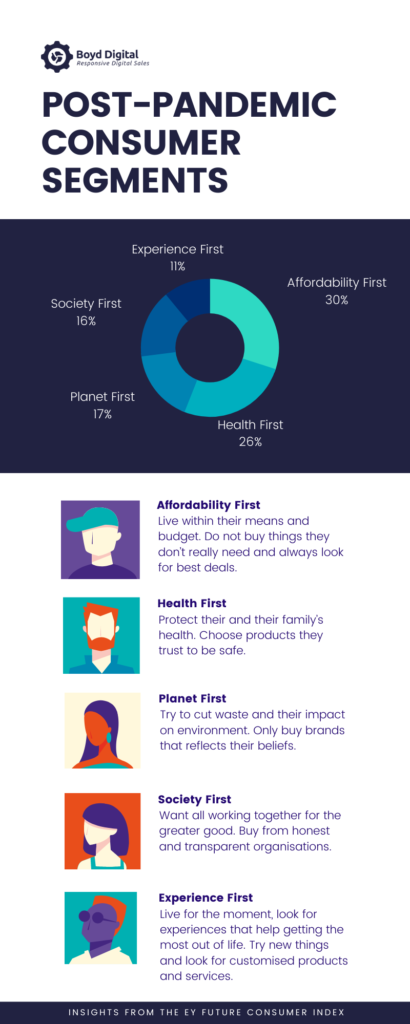As freedom is slowly restored, consumers will return to a world of new rules, safety considerations and potential social distancing norms.
This means that companies will need to adapt to a new kind of consumer — one with priorities, attitudes and behaviours shaped by the experience of living through a global humanitarian crisis.
In this blog, we are looking at 4 ways businesses can address the rapid changes in customer demand during and after COVID-19 in order to rebuild consumer trust and loyalty.
The Emerging Consumer Segments
According to EY Future Consumer Index insights, there will be five customer segments that will reappear after this global pandemic. Each segment reflects the different ways people expect to be living their lives, the things they will value most, and how they will make purchasing decisions:
- “Affordability First”: This is the biggest segment, representing 30% of consumers. They are the least educated consumer segment and are more likely to have low-income jobs that pay by the hour. As the most future-pessimistic consumers, their priority is to avoid buying unnecessary things and live by their means instead. This means that they don’t care much about what brands they buy, but just that the product meets their needs. The challenge brands will face with this consumer segment is demonstrating how their product differentiates from competitors beyond the price tag.
- “Health First”: This is the second-largest segment, representing 26% of consumers globally. It is not surprising that many consumers are focused on protecting their own health and that of their family. In fact, 57% say that ‘ healthy or good for me’ has increased in importance in the products they buy. This sentiment is going to guide the purchase decisions they make and retailers will need to take a disciplined approach to make consumers feel safe by demonstrating the health of their products and the safety of their spaces.
- “Planet First”: The 17% in this segment are spread across all age and income groups and they are all equally determined to cut waste and reduce their environmental footprint. They are willing to pay a premium for ethically sourced (40%), sustainable goods and are most likely to support local brands. In order to appeal to this consumer segment, brands will need to create transparency around their brand that will build consumer trust.
- “Society First”: This segment is made up of 16% of consumers globally, and it represents the people who believe that ‘everyone should work together for the greater good’. Motivated to act in a way that benefits society, they want brands to do the same and to provide proof that they are genuinely putting the needs of society and the community on par with profits. They also demand that organisations have clear values and purpose. This consumer is predominantly an urban professional with a graduate or doctoral degree who ‘will support domestic brands produced locally in the long-term’ (55%). To attract this consumer, brands will need to ensure that their portfolio of products and services is consistent with their values.
- “Experience First”: This segment represents 11% of consumers who intend on living for the moment. This means that they are always looking for experiences that will help them get the most out of life, including seeking products and services that feel personalised. More than half of them are Millennials or Generation Z and they are the least anxious about their health and finances, meaning that they won’t shy away from going out and eating in restaurants as soon as this is possible again. Organisations marketing to this segment will need to constantly innovate in order to keep their brand relevant to a consumer who is always on the lookout for something new.
(Click here for a higher-resolution version of the infographic.)
Share this Image On Your Site
1. Re-evaluate Your Offering and Brand Focus
Taking into account the changes in consumer attitudes and behaviours we explored above, brands will need to make sure that their products, services and experiences suit their target audience’s future needs and values. In some cases, this may mean completely re-branding and altering the brand’s core values, and in other cases, it may simply require brands to refresh their approach by offering a more compelling proposition.
For example, we saw many online stores selling medical supplies such as hand sanitisers and fashion labels sewing face masks, once the pandemic began to meet a need in the market. When things start to wind down, brands will need to determine if those products are still appropriate to sell and if they should become permanent fixtures of their inventory.
But perhaps the greatest challenge retailers will have to face when they reopen their stores is attracting a much more risk-aware consumer. The data collected by The Future Consumer Index shows that 52% are planning to change the way they shop, with 70% of those consumers more concerned about hygiene and sanitation.
Therefore, consumers will expect retailers to continue taking measures to ensure their safety by adopting various consumer-friendly services such as contactless payments. This creates an opportunity for innovative retailers to use digital technology to facilitate customers’ physical safety without compromising customer service. This would involve creating a map of the journey customers take, from acquisition to loyalty, and working out how to replace any physical touchpoints with digital ones.
With this in mind, we can expect to see an increased use of mobile devices as an interface, as well as wider use of voice commands and face ID in an effort to minimize in-store physical touch and proximity.
2. Improve Your SEO
Whether you’re a local retail store or a global franchise, organic search is part of nearly every consumer’s research process. Are you positioned to appear in response to searchers’ relevant queries?
Now more than ever, people are looking for guidance and help. This gives you the opportunity to build your brand’s share of voice in your industry by providing expert advice and accurate information on the topics that are most important to your target audience.
The content you create, optimise and publish today will serve your brand in the future throughout the economic recovery.
Here are a few things you can do today to enhance your SEO
- Make sure outdated landing pages are updated/removed and redirected.
- Go over your social accounts and ensure the information in your business descriptions is accurate in light of COVID-related operational changes.
- Ensure your local listings have the correct hours and methods of contacting the business for service or support.
- Focus on legitimate link building and PR opportunities today to get captive audiences consuming and sharing your content.
- Update your most popular evergreen content.
3. Adjust Your Approach To Consumer Engagement
From external media to social, public relations and digital communications, brands will need to be prepared to react quickly in their messaging to consumers and employees as the ground shifts suddenly beneath their feet. This will not only help avoid reputational damage, but it will also help brands keep up with consumers’ constantly evolving needs.
In other words, brands will need to drive marketing and communications agility both short- and long-term. For example, Nike has mobilised around new messaging embracing empathy and transparency in response to consumers’ changing expectations.
The ‘Play for the World’ campaign, created by Wieden + Kennedy
View this post on Instagram
Here’s what you can do to boost customer engagement:
- Urgently audit brand communication across all digital marketing channels.
- Set up immediate social listening to assess sentiment.
- Build a new communications plan to showcase an evolved brand vision and values.
4. Prioritise Digital Journeys and Optimise Digital Touchpoints
An experience like COVID-19 has made it more critical than ever to be able to segment customers using first- and third-party data in order to create specific personas and implement effective engagement and personalisation strategies.
The challenge is to create customer journeys that feel consistent and are successful at engaging the consumer every step of the way – from acquisition to loyalty. To achieve this, brands will need to identify points of friction along consumers’ path to conversion and eliminate them. Here’s what you can do to improve customer engagement and experience:
- Identifying pain points and ‘quick fixes’ in customers’ digital journeys.
- Accelerate customer segmentation, digital lead generation and nurturing.
- Amplify existing e-commerce capabilities and capacity.
Planning Ahead
COVID-19 pandemic is shaping irreversible changes in consumer values, habits, and spending behaviours. To stay relevant, companies need to reframe their growth strategies around evolving consumer behaviours. Those who fail to act fast and continue with their business-as-usual pre-pandemic approach will risk being left behind.
We can help you transform these new market developments into business opportunities through effective digital marketing strategies. For more information, please contact our team.


